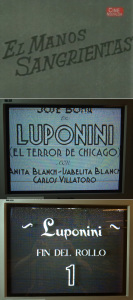
“Latin American Film Research in the Twenty-First Century”
This week, Mediatico surveys the latest Cinema Journal 54.1 InFocus dossier on “Latin American Film Research in the 21st Century” edited by Ana M. Lopez and Dolores Tierney with essay contributions by Rielle Navitski and Nicholas Poppe. It also looks at the joint Cinema Journal/Media Commons venture InMediaRes in which the InFocus contributors (and guest poster, independent writer and film curator, Misha MacLaird) post further ideas about Latin American film culture. The book reviews for the latest Cinema Journal have also been handed to the Latino/a Caucus and a list of books reviewed is included at the end of this post.
As has been the practice with other recent issues of Cinema Journal the InFocus dossier for the current issue, has been given over to one of the Society for Cinema and Media Studies’ Caucuses. Taking as a prompt two recent events in Latin American media: Alfonso Cuaron’s Oscar win for best director (Gravity) and the sad loss of Brazilian documentarian Eduardo Coutinho, the SCMS Latino Caucus has taken the opportunity to approach metatextual issues of trans-nationality, research accessibility, corpus building, and history in Latin American media scholarship.
Nicolas Poppe’s essay, explores how recent critical studies have approximated Argentine, Brazilian, Hollywood, and Mexican films of the early sound period in new ways. Poppe looks at how scholars both inside and outside Latin America sound out understandings of national cinema and transnationalism. Outlining the ways in which national cinema and transnationalism have come to be understood in existing research, Poppe also provides an important metacritical introduction to the early sound period in Latin America, raising important questions for ongoing research into this period.
Rielle Navitski’s essay provides a remarkably useful and concise guide to online resources for historical research on Latin American cinema, from audiovisual material and iconography to digital newspapers and magazines, and she highlights the theoretical and methodological questions raised by digitization in the context of Latin American film historiography. For instance, Navitski explores the opposition between open-access models, favored by Latin American cultural institutions and linked to a rhetoric of cultural patrimony, and access by subscription-only models, whether on an individual or institutional basis, which are favored in the United States, where some of the most comprehensive collections of Latin American periodicals and documents are housed. She also suggests that even though the digitization of archival materials represents an important step forward in our ability to research the cinema and media of the region, there is much we potentially lose when we “research” from home and office instead of in physical archives.
My essay maps the emerging research area of cult cinemas in Latin America. Seeking to explore how to begin the process of writing a history of cult cinema in the region, I highlight the necessary differences and problems of cult film paradigms established in US and European scholarship in their assignation to Latin American texts. I also look at the areas the nascent history of cult cinema already being written across the region needs to explore, as well as the potential pitfalls of directly mapping some cult film practices (“talking back to the screen”) onto a Latin American context.
Ana M. López’s piece, inspired by recent work on inter- mediality and the cinema, media, and arts, presents an argument for the field to assume an intermedial “lens” with which to understand the complicated contemporary mediascapes in Latin America as well as to posit new historiographical frames through which to illuminate the history of Latin American media at nodal points of intermediality. Thus, she argues that an interme- dial approach can help us understand the complex relationship between early sound cinema and radio in the region, for example, and that the 1950s and 1960s are also a possible nodal point (radio, cinema, and television) that bears further exploration from this perspective.
Companion posts for these essays – a number of which are fittingly to do with digital media, specifically YouTube and other online viewing platforms, went live last week on the Cinema Journal/ Media Commons co-venture InMediaRes:
(Monday) My post thinks about the implications of doing film research (and watching cult films like The Braniac/El Baron del terror) solely on YouTube.
(Tuesday) Ana M Lopez’ post elaborates on an illustrative example of intermediality in Brazilian mediascape, looking in depth at the TV Globo telenovela Cheias de charme (Full of Charm, 2012).
(Wednesday) Nic Poppe’s post looks at the role of television in shaping Latin American film cultures – and muses on his own experience of tracking down Jose Bohr’s Luponi
(Thursday) Misha MacLaird’s post thinks about how the juxtaposition of Pepe el Toro (Ismael Rodriguez, Mexico, 1951) and the various Rocky movies (and symbolically of rival film industries) within “Pepe el toro vs Rocky Balboa” facilitates an easy entry for students into a discussion of larger issues in film studies, such as comparing genres across cultures and/or historical periods. The online navigation in public audiovisual archives such as YouTube offers further examples how classic cinema is fragmented in its contemporary consumption and its icons and cultural significance have been re-appropriated by viewers.
http://www.youtube.com/watch?feature=player_embedded&v=R1ZYxAgnaOE
(Friday) Rielle Navitski’s post explores how reading O Brasil Pitoresco (1925) across online archives can help uncover the politically charged meanings of non-fiction images of the nation in the 1920s.
Book Reviews:
Media Power and Democratization in Brazil: TV Globo and the Dilemmas of Political Accountability by Mauro P. Porto reviewed by Leslie L. Marsh
Aesthetics and Politics in the Mexican Film Industry by Misha MacLaird reviewed by Miriam Haddu
Transition Cinema: Political Filmmaking and the Argentine Left since 1968 by Jessica Stites reviewed by Antonio Gómez
Cinema and Inter-American Relations: Tracking Transnational Affect by Adrián Pérez Melgosa reviewed by Catherine L. Benamou









